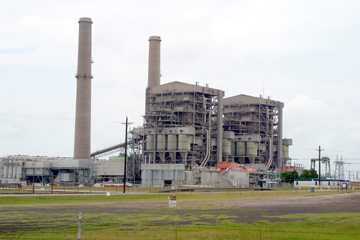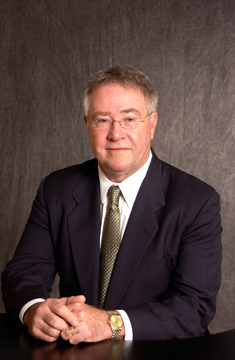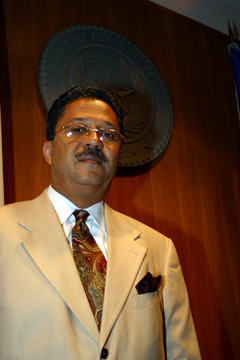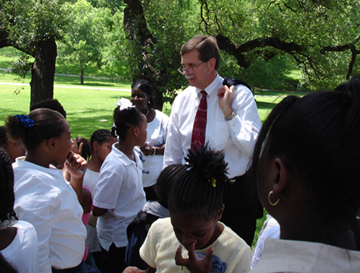| Feature: Wednesday, June 08, 2005 |
 Big Brown, the first lignite-fueled power plant in Texas, belches out 82,000 tons of sulfur a year. (Photo by Vishal Malhotra)
Big Brown, the first lignite-fueled power plant in Texas, belches out 82,000 tons of sulfur a year. (Photo by Vishal Malhotra)
|
|
‘This is the utilities’ dirty little secret —
that the worst plants ... are putting out
the least electricity.’
|
 Lignite from this coal mine that fuels Big Brown helps produce the mercury that is accumulating in Texas lakes, soil, and fish. (Photo by Vishal Malhotra)
Lignite from this coal mine that fuels Big Brown helps produce the mercury that is accumulating in Texas lakes, soil, and fish. (Photo by Vishal Malhotra)
|
|
‘The prevailing winds blow the pollution from these plants directly across southeast Fort Worth.’
|
 Fling: ‘Pollution in the air is playing a major role in asthma among Fort Worth children.’ (Photo by Vishal Malhotra)
Fling: ‘Pollution in the air is playing a major role in asthma among Fort Worth children.’ (Photo by Vishal Malhotra)
|
|
Texas ‘is such a lax state in enforcing environmental laws.’
|
 Goodman: ‘Global warming is real.’ (Courtesy of Toby Goodman)
Goodman: ‘Global warming is real.’ (Courtesy of Toby Goodman)
|
 Brooks: ‘It is environmental injustice.’ (Photo by Vishal Malhotra)
Brooks: ‘It is environmental injustice.’ (Photo by Vishal Malhotra)
|
 Burnam: ‘Whatever the ... power generators want, they get.’ (Courtesy of Lon Burnam)
Burnam: ‘Whatever the ... power generators want, they get.’ (Courtesy of Lon Burnam)
|
|
A D V E R T I S E M E N T
|
|
|
|
A D V E R T I S E M E N T
|
|
Ill Winds
Power plants blow no good for
increasingly sick Fort Worth kids.
By BETTY BRINK
Once, in a Fort Worth far, far away, the winds blowing in from the south and southeast in the summer brought nothing more than an occasional welcome shower, or even the tail of a tropical storm, to cool a sweaty body in the hellish heat. But for about the last decade, going outdoors in the summertime and “catching a breeze” has taken on a sinister new meaning around here.
These days, those once-benign winds too often carry a chemical fog of pollutants that many health experts say cause — or make worse — incapacitating lung and heart diseases and, for some, lead to premature death. Words like “ozone” and “particulate matter” have become household words — especially in homes with an asthmatic child.
In Fort Worth, the numbers of such children suffering from the debilitating and sometimes fatal disease are growing dramatically, asthma specialists here say, and the rates are highest among the poor. The most recent city health department survey, from 2003, shows that childhood asthma rates are high in all sections of the city — and that the highest rates are found within four low-income and mostly minority neighborhoods clustered on the city’s southeast side.
While the health department is noncommittal about the causes of the high incidence of asthma here, respiratory specialist John Fling of the University of North Texas Health Science Center isn’t. “Pollution in the air is playing a major role,” he said, especially the particulate matter from coal-fired power plants.
Such facts and conclusions come as no surprise to Tarrant County Commissioner Roy Brooks, who said he has long known that the children from the neighborhoods where he grew up are suffering disproportionately from the disease. “There is a direct correlation between the asthma in these children and the nearby cement kilns in Midlothian and the old, coal-fired power plants” of East Texas, he said. “The prevailing winds blow the pollution from those plants directly across southeast Fort Worth. ... It is environmental injustice.”
A recent national report, based on information gleaned from EPA documents, adds weight to Brooks’ accusation, shedding more light on why Fort Worth — a city that hasn’t had a coal burning power plant in operation since the 1920s — seems to be getting more than its fair share of the soot that turns the blue skies brown and sends more and more kids to the emergency room each summer: Three of the 50 worst coal-fired power plant polluters in the nation sit about 100 miles south and southeast of Fort Worth, sending their noxious wastes winging toward the Metroplex on the prevailing winds. Along the way, these pollutants hook up with toxic emissions from the nearby Ellis County cement plants, creating a kind of unholy alliance of airborne menace for Tarrant County kids, old people, and everyone in between.
“The real tragedy for the health of the public from industrial pollution is that this problem is preventable,” said Eric Schaeffer, founder of the Washington D.C. Environmental Integrity Project, but better known as the man who in 2002 resigned his post as director of the EPA’s Office of Regulatory Enforcement in a very public protest against the Bush administration’s rollback of environmental regulations and enforcement. Today, he is using his expertise and the EPA’s own documents to expose the polluters he couldn’t bring to court back then.
Schaeffer and co-author Ilan Levin of Austin have just released a damning report called Dirty Kilowatts, America’s 50 Dirtiest Power Plants, compiled from the most current 2004 data taken from EPA and other federal documents. The report looked at the nation’s 359 largest power plants — those that generate at least 2 million megawatt hours of electricity and account for almost 90 percent of the nation’s electrical power — and found the 50 worst, based on volumes of pollution per megawatt hour of electricity generated, and the total annual amount of each pollutant emitted.
In Texas, 16 coal-fired plants made Schaeffer’s list. Three are in Fort Worth’s backyard: TXU’s Big Brown in Freestone County, TXU’s Martin Lake plant near Rusk, and Reliant Energy’s Limestone plant near Mexia. They sit a few miles from one another in a loose semi-circle 100 to 150 miles southeast of Fort Worth.
One of the worst is the 34-year-old Big Brown Steam Electric Station near Fairfield just off I-45. It’s the first lignite-fueled power plant built in Texas and one of the dirtiest, Schaeffer said, in pounds of sulfur dioxide emissions. Sulfur dioxide is a major contributor to the fine particle emissions that trigger asthma attacks and “cause more than 20,000 premature deaths from lung and heart diseases each year,” he said. “Those aren’t my figures,” Schaeffer told Fort Worth Weekly in an interview from his Washington office. “These come directly from EPA data and a peer-reviewed study done by the Harvard School of Public Health.”
In 2004, Big Brown’s tall smokestacks belched out 82,023 tons of sulfur dioxide into the air, according to the report. “Sulfur dioxide can travel 1,000 miles,” Schaeffer said. “If you live right under the smokestacks you might be better off. Those tall stacks are designed to carry that stuff as far away as possible.” National Weather Service data show that the prevailing winds blow across Fort Worth from the south and the southeast, putting the city directly in the pollutants’ path. The plant was also responsible for 9.9 million tons of carbon dioxide, the major contributor to greenhouse gases.
Big Brown, like most of the plants in the report, is grandfathered — that is, it does not have to meet the more stringent pollution control requirements of the Texas Clean Air Act because it was already up and running when amendments to the act were passed in 1971. In each successive year since, the power plant lobby has successfully staved off attempts by clean-air advocates to force these plants to install the best available emission control technology. “State-of-the-art scrubbers could take out 95 percent of the sulfur from these old plants and make the air cleaner for us all,” Schaeffer said.
The report shows just how dramatic a difference clean technology can make. The 50 dirtiest plants averaged 22.8 pounds of sulfur dioxide emissions per megawatt hour, compared to one pound per megawatt hour for plants equipped with the latest, most efficient scrubber technologies.
But there is an even more ominous twist to this tale of dirty kilowatts: What is the public getting from these plants in exchange for allowing them to pollute with impunity? Not that much, it turns out. EIP research found that the 50 worst-polluting plants account for “up to 50 percent of sulfur dioxide, 42 percent of mercury, 40 percent of nitrogen oxides, and 35 percent of carbon dioxide” emitted into the air and water in 2004. However, because most are old and inefficient, they generated only 14 percent of the electricity that went into the nation’s grid that year. That amount of energy, Levin said, could easily be replaced by conservation and wind power without consumers having to give up so much as a hair dryer.
“This is the utilities’ dirty little secret — that the worst plants in terms of pollution are putting out the least electricity,” said Tom “Smitty” Smith of Austin, director of Texas Public Citizen, an affiliate of Ralph Nader’s consumer group. “That’s what is new in this report and what makes it so important to the public dialogue.”
TXU spokesman Tom Kleckner dismissed the EIP study as “only a snapshot” of plants like Big Brown and a fuzzy one at that. He denied that the company’s coal-fired plants are a major contributor to the Fort Worth/Dallas area’s bad air. Big Brown is a reliable plant with good emission controls “that capture more than 99 percent of the plant’s particulate matter,” he said.
Kleckner also touted TXU’s environmental record, citing habitat restoration that has reclaimed about 12,000 acres from the lignite mining operation near Big Brown. The land, he said, is now home to deer, foxes, egrets, ducks, geese, and American bald eagles and ospreys that winter every year at Lake Fairfield, built to cool the power plant. However, lignite surface mining, which for 30 years has turned giant swaths of verdant East Texas countryside into wasteland, continues. The Texas Railroad Commission’s web page lists 21 lignite mines operating in Texas in 2005, six of them owned by TXU, including Big Brown, Monticello, and Martin Lake. Because mercury is found in high concentrations in lignite, all three plants emit thousands of pounds of mercury each year, according to EPA tracking documents.
Still, Kleckner said, “We’re proud of our environmental record.” When asked about the mercury pollution, he said that the company has experimented with several proposed methods designed to reduce mercury emissions, but that none so far have worked. However, Karen Hadden, deputy director of the Austin-based sustainable development coalition known as SEED, told the Weekly that a new technology using materials to absorb mercury, developed by the University of North Dakota, is being used at a plant in Stanton, N.D., and is reducing mercury emissions by 95 percent. Kleckner said he was unaware of the North Dakota development.
And while acknowledging that mercury is a serious byproduct of lignite, he said other claims of supposed harm from power plant pollution are overblown. “Power plants are only a small part of the ozone and particulate matter problems,” he said. “Most of the pollution comes from automobiles.” In fact, TXU is considering building more coal plants around the state, he said. With the company’s excess lignite reserves and the high cost of cleaner-burning natural gas, “coal is today’s most economical fuel.”
The three plants that form a semi-circle upwind of Fort Worth all burn the mercury-rich lignite. North Dakota is the only other state in the nation besides Texas that burns the soft coal in its power plants. In 2004, the Limestone plant led the nation in mercury emissions, sending 1,800 pounds of the highly toxic metal into the air that year, which eventually settled back in Texas rivers and streams, where it has accumulated in fish in Texas lakes to such a degree that many are now off-limits to fishing for food. Mercury is considered especially dangerous to a developing fetus, causing neurological damage and birth defects. It has been regulated as an air toxin for 35 years for all but one industry — power plants, which produce roughly 40 percent of the nation’s airborne mercury, Schaeffer said. Recent Congressional efforts to close this regulatory loophole have been stalled by Congressman Joe Barton, the powerful head of the House Energy and Commerce Committee and the “Smokey Joe” of Ellis County, the home of cement kilns that emit thousands of pounds of mercury yearly. A large portion of Barton’s political funding comes from the cement and utility industries, and Barton has gone to extraordinary lengths to protect their right to pollute (“Poisonous Plumes,” Feb. 11, 2004, and “Wheezy Street,” Aug. 6, 2003).
Martin Lake made the Dirty 50 in three pollutant categories: In 2004, it emitted 20 million tons of carbon dioxide, one of the greenhouse gases linked to climate change; produced 56,000 tons of sulfur dioxide; and spewed out 1,027 pounds of mercury, making it eighth in the nation in mercury contamination.
And in fact, Texas’ power-plant pollution may be about to get worse — much worse.
On June 27, a state permit hearing will be held in Waco for a coal-fired plant to be built near that city by LS Power of St. Louis, Mo. LSP’s permit application calls for up to 1,180 pounds of mercury to be emitted each year, which Public Citizen’s Smith said would put that plant in the top 10 of mercury polluters in the nation, along with Limestone. If the Texas Commission on Environmental Quality approves that permit, the LSP facility will become the fourth coal-fired plant sending its toxins our way — and the closest, only 75 miles south of Fort Worth.
In recent years, from June through September, the Fort Worth/Dallas metropolitan area’s ozone alerts have steadily grown worse, both in the numbers of days that alerts are issued for and the severity of the alerts. They range from yellow (bad only if you’re extremely sensitive, say a kid with asthma or an adult with emphysema) to orange (unhealthy for those with just about any kind of lung problem and for the very young and very old), red (unhealthy for all) to purple (don’t even think about going outside.) The only color that hasn’t shown up in the pollution alerts is black (break out the gas masks). And according to TCEQ data, this year began with a run of bad air alerts earlier than most.
Cowtown’s 2005 ozone season opened on May 6, long before the hazy days of summer, with 10 days of moderately unhealthy (yellow) ozone levels recorded that month by the air quality monitor at the Arlington Municipal Airport in eastern Tarrant County. Particulate matter was also higher than normal during that time. For healthy adults and kids, air quality at that level — just a notch below the go-ahead-and-take-a-deep-breath green — is more a discomfort than a serious health threat. But for those with pre-existing lung diseases such as childhood asthma, “the earlier the exposure to bad air each year, the greater the aggravation” of the disease, said Norman Trieff, medical researcher and professor in the School of Public Health at the University of North Texas Health Science Center. With extra stress earlier in the season, such folks’ conditions will worsen more quickly.
John Fling, the Health Science Center professor and pediatric allergist, said that the number of children here who are coming down with asthma is on the rise, if the numbers of patients he sees at his campus office and at the college’s five family medicine clinics are any indication. “We have definitely seen an increase in office visits of children with asthma over the past 25 years,” he said, “and we are getting a lot more now than before.”
His UNTHSC colleague agreed. “Respiratory ailments [in North Texas] are worsening,” Trieff said, “and asthma is a growing concern. ... Power plant pollutants, as well as those from the cement plants in Midlothian, are adding to what is clearly a public health problem.” The growth of respiratory ailments that are caused by pollution, he said, can be blamed on a mixture that’s just as potent as any chemical reaction: the “interaction of industry with politicians.” Texas, he said, “is such a lax state in enforcing environmental laws.”
Trieff and a group of colleagues recently completed a review of hospital admissions for the year 2002 in Midlothian — where cement and steel plants dominate the economy and produce toxic emissions that dominate the air across North Texas — and found a “a higher rate of asthmatic admissions to the hospitals there than the state average.” Such data tells him, he said, that “cement plants ... can cause or worsen asthmatic problems.” The group has recently applied for a National Institutes of Health grant “to further explore the health effects of the cement plants,” he said.
Particulates and ozone are highly irritating to the respiratory system, he said. “They worsen pre-existing conditions and can be the underlying cause of asthma or emphysema if the exposure is long enough.”
“There are certainly more problems during high ozone days,” Fling said. “More asthmatic children come to our offices and our emergency rooms on those days. There is definitely a connection to particulate matter and ozone.”
The children of the poor are affected more severely by air pollution, he said, for complex societal and economic reasons, not the least which is the fact that thousands of them were dropped from the CHIP rolls two years ago when the Texas Legislature took a meat cleaver to the program. (The legislature this year restored funds for some but not all of those cut in 2003.)
In Fort Worth, some of those children can be found in the dry language and statistics of a community needs assessment survey done by the Fort Worth Health Department in 2003. That year, 16.4 percent of all those surveyed reported suffering from asthma — much higher than the statewide average of 6.2 percent; for children, the rate here jumped to 23 percent.
“After stratifying the reported asthma data by neighborhood police districts,” epidemiologist Dorian Villegas wrote in a cover letter to the Weekly, “the findings suggest that there is a higher reported asthma prevalence among households with children under 17 years of age located mainly within [four neighborhoods] in the east region of the city.” Those neighborhoods — including Meadowbrook, Mosier Valley, Woodhaven, the Near Southeast Side, Poly, and the Far Southeast — are largely populated by blue-collar workers, the poor, and minorities. The areas generally coincide with the city council districts now represented by Donavan Wheatfall, Kathleen Hicks, and Becky Haskin — and they are the portion of Fort Worth hit first by winds from the south.
The difference between rich and poor neighborhoods was rather dramatic: In the four southeast and east-central Fort Worth neighborhoods highlighted by Villegas, about a quarter of all households (23.6 to 26.7 percent) included at least one asthma sufferer under the age of 17. Only one neighborhood west of I-35 had higher numbers, and it, too is in south Fort Worth — NPD district 10, which runs south of I-30 to the Crowley city limits, reported a 30 percent childhood asthma rate. Other districts west of I-35 reported rates of 12 to 19 percent, substantially below the citywide average of 23 percent.
Figures from the 2003 assessment and from 1998, the only other year for which the city has data, show that overall asthma rates did not change much, but remained much higher than the state average. In 1998, 18.2 percent of households reported asthma patients, compared to 16.4 percent in 2003. But the 1998 study didn’t break out the under-17 group that Fling said is showing the greatest increase.
“My fellow clinicians and I have observable evidence of this increase over a much longer period of time,” he said. It is also reflected in the efforts of the National Institutes of Health, he said, which has been putting out updated national guidelines since 1994 on the treatment of childhood asthma, “a direct result of the increase in the numbers of cases and because we [society] have done a poor job of taking care of children with asthma.”
Childhood asthma affected about 3 percent of the population in the 1960s, Fling said, but that figure has climbed above 25 percent today. These are “dramatic increases,” he said, even when you take into account Fort Worth’s substantial population growth since 2000. “Everything we know about the increase in asthma suggests strongly that there is a relationship with the increase in pollution.”
Commissioner Brooks sees a direct correlation between the numbers of reported asthma cases and the almostdaily doses of pollution from the cement plants and the power plants. The pollution affects all of Fort Worth’s children, but especially the children who live in the low-income neighborhoods on the east side of town, he said. “This is a serious public health issue that is not being addressed.”
“These things [the connection between pollution and lung diseases] have been known about for years,” Fling said, but the reason we are still dealing with it is “all politics. ... It’s time to make a change. It’s time for a public outcry. A huge amount of money is going to have to be invested. If we’re not willing to do that, our children will continue to live with our mistakes.”
But help for these kids — and for others whose health is being damaged by industrial pollutants — won’t be coming anytime soon from the one source in Texas that could make a difference, the legislature. A proposal authored by State Rep. Toby Goodman would have required the Texas Commission on Environmental Quality to adopt stringent new regulations taking the health effects of pollution into account when considering plant permit requests. For example, the Arlington Republican’s measure, tacked onto a House bill regarding reporting of unauthorized pollution emissions from industrial plants, would have required that contaminants leaving such a plant could not increase the risk of cancer in an exposed person by greater than one chance in 1 million. The amendment was defeated. “I always lose to the industry lobbyists,” Goodman said.
“The air in Tarrant County is dangerous, and of course it’s getting worse,” said State Rep. Lon Burnam, a long-time environmentalist and Democrat who represents a Fort Worth inner-city district and whose environmental bills seldom see daylight, much less victory, in the Republican-controlled Texas House. “We have a legislature that refuses to deal with this crisis. This is a state of ExxonMobil. Whatever the oil and gas industry, the power generators, and the concrete companies want, they get. What they don’t want is any more regulation, and to hell with people’s health.”
Goodman, on the other side of the aisle, uses gentler rhetoric, but with the same purpose in mind. He’s one of the few Republican legislators to break with his party in its traditional opposition to anything that even smells of environmental regulation. Last year, Goodman fought Barton, one of the most powerful Republicans in Congress, in an effort to get the EPA to add Barton’s home county, Ellis ,with its polluting cement plants, to the group of North Texas counties named by the agency as being in non-attainment of the Clean Air Act’s stringent ozone standards. That battle was won; Ellis is now one of the “dirty nine” along with Tarrant, Dallas, Collin, Denton, Johnson, Kaufman, Parker, and Rockwall, all on EPA’s hit list of counties that must reduce ozone to acceptable levels by 2010 or face serious economic sanctions.
The EPA, of course, has been threatening such sanctions since 1991, and each deadline has been extended; environmentalists such as Burnam think this time the agency may finally lower the boom. In any event, he said, the threat has worried the area’s county judges enough that they formed a coalition last year to help develop a clean-air plan for the region that will meet EPA ozone standards. One of their efforts bore fruit — the inclusion of Ellis County in the dirty nine. But Public Citizen’s Smith said, “Until those dirty power plants upwind of the Metroplex clean themselves up, there’s no hope for the area to meet the EPA standards.”
Goodman’s amendment, which would have given TCEQ the regulatory power to protect the health of those living near or downwind of new or refitted industrial plants, was fought by a group led by the Texas Chemical Council and State Rep. Dennis Bonnen, an Angleton Republican who chairs the House Environmental Regulation Committee. Bonnen told the Houston Chronicle that “toughening of pollution laws would drive out industry. ... The sign would say, `Texas: Closed for Business.’”
Four other bills from House Democrats that would have toughened laws governing pollution releases never got a hearing in Bonnen’s committee. “Bonnen’s committee is better named the Environmental Deregulation Committee,” Burnam said. “Nothing gets out if it’s going to hurt industry.”
“This body’s been very protective of industry at the expense of the health of its citizens,” State Rep. Jessica Farrar, an author of one of the bills killed by Bonnen, told the Chronicle.
But at least one person saw some rays of hope in this year’s legislative session. “Toby got a few Republicans to vote with him [on his amendment],” Smith said. “It’s the first time we’ve seen some concern about the health of the Metroplex.”
For Goodman, the issue doesn’t turn on politics. “This pollution from those old coal-burning plants in East Texas and the refineries in Harris County goes right across my district, Arlington and Mansfield. I’m concerned about seniors, children with asthma. We fought to include [Ellis County] in the non-attainment counties of North Texas. I went against my own party and Joe Barton. Ellis is the largest point source of pollution in an eight-county area, putting out about as much pollution as 870,000 cars sitting on idle.
“Global warming is real. These are facts that can’t be denied. What is happening to the planet is dangerous for my constituents and my family,” Goodman said.
“Republicans who have kids and have to take them to Cook Children’s [Hospital] because they’ve had an asthma attack ought to understand that this isn’t a partisan issue, it’s a health issue. It hurts us all.”
 Email this Article... Email this Article...
|
|

